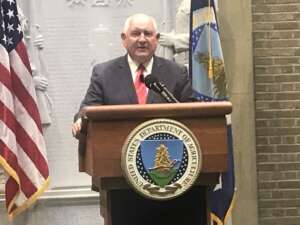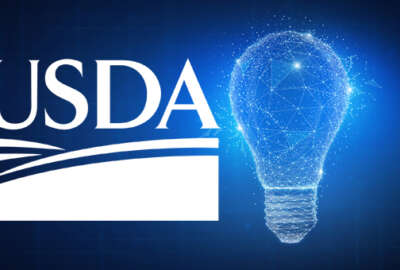

The Agriculture Department is expanding its contact center and customer experience efforts to more bureaus over the next year as part of its IT modernization...
The Whitten Patio in the Agriculture Department’s Jefferson Drive building served as a backdrop for more than two dozen examples of how the agency has changed over the last two years.
The recent USDA Impact Expo was a celebration of the changes brought on by the agency’s partnership with the General Services Administration’s Centers of Excellence unit.
Program leaders from nearly every bureau didn’t mention the cloud or talk about the tools behind the agency’s leadership dashboard. Instead, the displays highlighted how actual services have transformed.
“We’ve got the tools in hand to bring a lot of that data and information that was residing in your mission areas and in many places, and we put it visually there so leaders can look there and help us make the best decisions. Not only leadership, but people down in the effort because my assumption is that everybody wants to be better and that’s what these kind of tools help us to do. These dashboards really give us a data analytics platform to enable us to make the best decisions,” said Agriculture Secretary Sonny Perdue in a speech to kick off the Oct. 31 expo. “We are streamlining efforts for other Americans as well although they may not know they interact with USDA. The Forest Service has launched an e-permit application for Christmas trees. It’s a program that has proved to be highly successful.”

With the expo, Agriculture did something few agencies do and more should—show off what they accomplished after more than two years of focused work.
As a lighthouse agency for the IT modernization services provided by the Centers of Excellence, Perdue said these technology modernization efforts have helped break down bureaucracy and streamline services. GSA and USDA recently decided to end their relationship across several of the CoEs with Agriculture taking over many of the initiatives.
Perdue said the key to many of these efforts is simply remembering, people do business with people. That’s the starting point for the modernization efforts.
To that end, USDA and the CoEs are focusing on improving USDA’s contact center in 2020.
Anil Cheriyan, the director of GSA’s Technology Transformation Service, which houses the CoEs, said the CoEs help agencies look for simple questions to answer that will improve services.
“We’ve created the Ask USDA contact center. It’s really a state of the art contact center. It’s the ability to look at the intake of calls, connecting that to web, connecting that to chatbots, really that omni-channel experience so if you are a farmer and you are calling in, you are not hearing different things based on different answers so there is just one contact center,” Cheriyan said in an interview after his speech. “That’s just the beginning that’s a core capability that USDA now has. What we are helping them do is move that [capability] in by mission area so each mission area can then leverage this new contact center. I don’t know how many we will end up with, there are probably about 35 contact centers in USDA, but we might bring them down to a few.”
It’s that omni-channel experience for the citizen that many agencies have come to realize is their customer experience end-goal. Legislation like the 21st Century Integrated Digital Experience (IDEA) Act, and requirements in the President’s Management Agenda and Circular A-11 have pushed agencies to rethink what the customer experience looks like.
“If you are a citizen you don’t want to be bounced around with your phone calls for every single question you might have because the expertise lies in different areas,” Cheriyan said. “The omni-channel experience will bring it all together and try to make it as seamless as possible. You always will have specialist calls, but you want to have that one face and one USDA. That has been the strategic push from the secretary since day one.”
Cheriyan said USDA found success thanks to its decision to drive business process changes across the CoE initiatives.
Two of those initiatives, customer experience and contact centers, are among the CoE initiatives that have helped transform the agency over the last year.
Tamieca Hamlin, USDA’s co-lead of the customer experience center of excellence and contact center, said the agency is starting with tier 0 and tier 1 contact center help, meaning being able to answer the basic questions citizens may have about the agency. Through the CoE pilot, USDA is testing the contact center upgrades with about half the bureaus.
She said that way the bureaus can standardize across the technology platforms featuring natural language processing and interactive voice response.
“Some of these call centers are now stood up and some of them have no technology. Some of them are on a ‘swivel chair’ process. Some of them are just doing tier 1 and tier 0, and others are on several different tiers that are more complex,” Hamlin said. “In this process, we are doing it in phases. We can start modernizing the technology and the infrastructure and then build out the other tiers.”
After the infrastructure is ready, Hamlin said the next step is system integration across the tiers and building an external customer-facing portal.
“Right now, customers can go do the chat and a case can be created from there. But a customer, at some point, may need to log in to actually see their loan information or get an email where they can check a balance or something,” she said. “There are different levels so the doing the approach in phases is the right approach.”
Over the next year, Hamlin said infrastructure should be ready to enable the long term goals of the tier 3 or tier 4 contact center, the customer-facing portal and a centralized data repository. She said this entire effort is to give the customer a seamless experience.
Janna Kimosh, a senior customer experience strategist at USDA, said her office has helped bureaus see the difference between customer service and customer experience.
“Customer service is the interaction but customer experience is about the entire relationship,” Kimosh said in an interview with Federal News Network. “One of the things at the forefront is empowering our own employees. We believe they are the experts in their customers and in what they do. Sometimes they just need to be empowered in a way that removes barriers, removes administrative burdens and improves processes so they can ultimately provide better experience. Across many of the mission areas, they said they want to give their employees tools to allow them to provide that excellent customer experience.”
The customer service office worked closely with the bureaus to develop the processes and procedures for the contact center effort. Kimosh said their project leaders did “blueprint” sessions to understand the current set of processes that serve customers.
“What we’re working toward is developing a comprehensive knowledge base that allows whoever answers the phone to be able to look up the answer to your question. So you call one number and you get the answer to your question on the spot,” she said. “We are also incorporating the web, the email, the chat so no matter what your preferred channel of communication is you’re going to get the consistent answers, you’re going to get the accurate answer and you’re going to get it in a timely manner.”
She added USDA is measuring the success of its customer service efforts by seeing how farmers and producers are spending less time to obtain services and making those services easier to use.
“There are several ways they are measuring that impact on customers. They are out in the field talking to farmers. They are doing farmer roundtables. There is a survey when they come to the site asking what they like, what they don’t like and what could be made better,” Kimosh said. “We have a lot of exciting things happening here on improving internal customer experience. We are talking about process robotics to automate some processes and streamline administrative burden for employees. We have the OneUSDA Intranet, which is a site we are developing to provide information consistently, easily, at your fingertips for employees. There are tools, communications from leadership, they can ask questions back to leadership all in one place.”
Copyright © 2025 Federal News Network. All rights reserved. This website is not intended for users located within the European Economic Area.
Jason Miller is executive editor of Federal News Network and directs news coverage on the people, policy and programs of the federal government.
Follow @jmillerWFED


